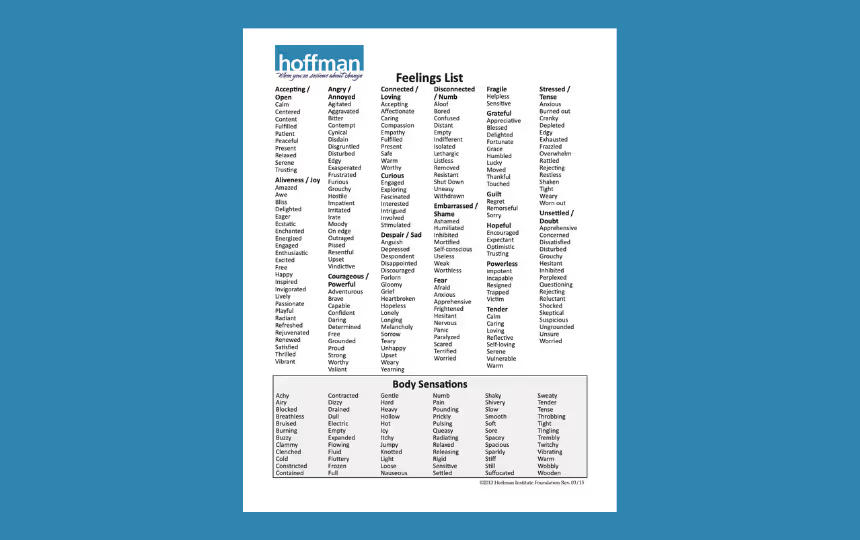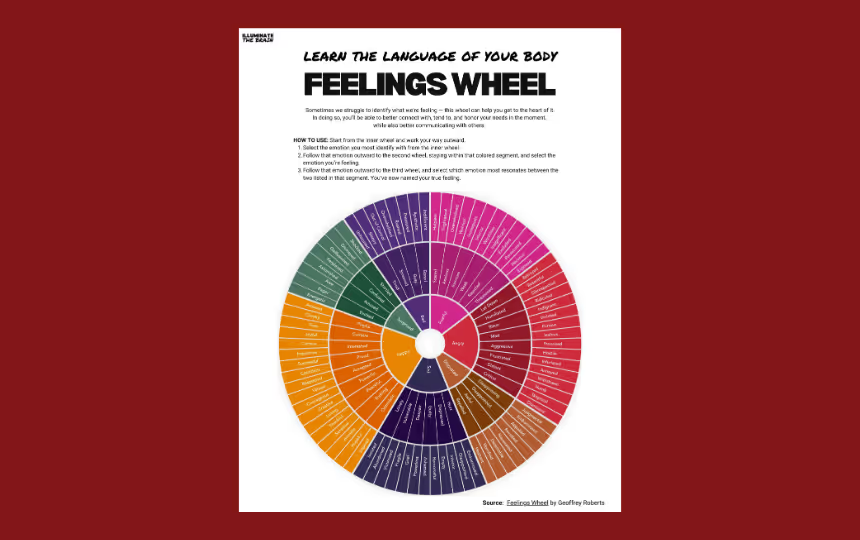Are you feeling upset with someone, either from a recent interaction or an experience you had in the past or as a child? Write a letter to them. Use it as an opportunity to be honest with yourself, truly vulnerable in expressing how you feel about the interaction, what you’re thinking about it now, and what this experience stirred up within you.
*If you’re currently feeling physically charged in your body from this interaction – i.e. you feel like your body is vibrating, constricted, hot, nauseous, drained, etc. – consider starting with some somatic movements or somatic breathing to help release the energy before writing.
Start the letter by identifying how you’re feeling. You can reference the Feelings & Sensations List, or Feelings Wheel, or Emotional Guidance Scale to help you pinpoint the feeling. Then write your side of the story. Allow yourself to get ugly or hostile if needed, or perhaps use the page as a brain dump to just purge all that's been festering inside – none of what’s written needs to make sense to anyone but you. Just do your best to keep bringing it back to how you've felt throughout the experience.
Now take a deep breath.
Contrary to part one, this letter is not about placing blame for your experience on someone else. It’s about reflecting on what this experience with this person stirred up within you.
While you focused on your feelings in part one, this next process asks you to look a bit deeper. There is likely a deeper emotion that you’re consciously unaware of that was triggered by the interaction. It’s often something like fear, guilt, shame, unworthiness, or insecurity. And it’s probably stemming from an inner child or shadow wound you’re subconsciously playing out in your adult life. To begin identifying that trigger point, ask yourself these questions and jot down your reply:
Then consider:
Now let’s transmute that stuck emotion into something that feels lighter, which will also help you untether from the weight of the experience and the person (if boundaries are needed). Consider each of the below and jot down your thoughts. Feel free to revisit this section at a later date if neither of the below resonate quite yet, sometimes all we need is a little time.
Once finished writing, either reread your letter (right away or after stepping away from it for a bit), or never read it again. But once you’re ready, dispose of it. Feel free to tear it up, burn it (safely), or toss it in the trash – whatever feels right to you. This physical action can serve as an energetic cleansing to show your mind, body, and spirit that this experience no longer holds power over you. Then take a deep breath, place a hand on your heart and the other on your belly, and thank yourself for doing this!
Write a forgiveness letter to yourself, if for example, you’re holding onto shame about something you did in the past. Write it as if you’re speaking to the version of yourself that you were then, and release yourself from the burden of shame, regret, insecurity, self-loathing, or unworthiness. Acknowledge that you did the best you could, with the information you had, at that moment in time, and forgive yourself by showing compassion towards that inner child within you and/or grant yourself gratitude for showing up now to transmute it.
“Holding onto anger is like drinking poison and expecting the other person to die” — an age-old saying attributed to the Buddha that applies to this practice.
When we hold onto emotions like anger, resentment, or jealousy against someone else, we trap that energy inside our body. Without a release valve, those emotions turn into a ticking time bomb, so to speak, that will eventually either implode (creating dis-ease in the body) or explode (wreaking havoc on our external world - relationships, work, finances, etc.). It can happen like a slow trickle continuously over time or abruptly. By writing a forgiveness letter of sorts, you (1) offer your mind and body a way to express and relieve themselves of those emotions, (2) shift your perspective, and (3) free yourself from the grips of these emotions regardless of another’s actions.
Use these while you give it a go . . .

Downloadable PDF created by the Hoffman Institute.

Downloadable PDF to reference while you learn your emotions.

Downloadable PDF to reference while you learn your emotions.

Care for “little you” by giving them space to be heard, felt, and nurtured in the ways you needed as a child — then gently reparent, so together you can begin to restore a sense of safety and love.

Lovingly explore and integrate the hidden or rejected parts of yourself to reclaim your most powerful, authentic Self.

Opportunity to shift our personal energy.
Explore the topic further . . .

Break limiting beliefs & patterns, promote physical & emotional healing, and transform your reality.

Learn the language of your body to better understand your needs, desires, boundaries, and truth.

A groundbreaking guide to rewiring your mind and breaking free from old patterns to create a new reality.

Lorem ipsum dolor sit amet, consectetur adipiscing elit. Suspendisse varius enim in eros elementum tristique. Duis cursus, mi quis viverra ornare, eros dolor interdum nulla, ut commodo diam libero vitae erat. Aenean faucibus nibh et justo cursus id rutrum lorem imperdiet. Nunc ut sem vitae risus tristique posuere.
Lorem ipsum dolor sit amet, consectetur adipiscing elit. Suspendisse varius enim in eros elementum tristique. Duis cursus, mi quis viverra ornare, eros dolor interdum nulla, ut commodo diam libero vitae erat. Aenean faucibus nibh et justo cursus id rutrum lorem imperdiet. Nunc ut sem vitae risus tristique posuere.